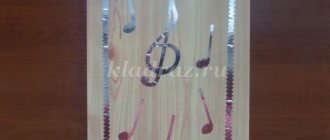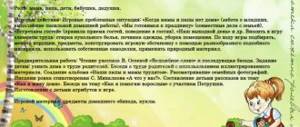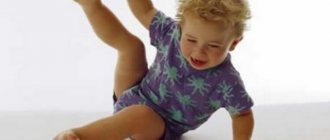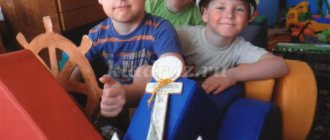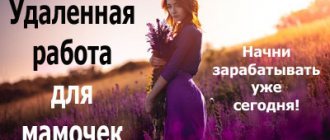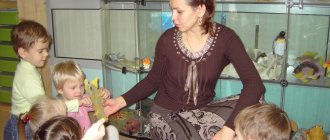Role-playing game "Zoo"
Story-role-playing game “ZOO”
TARGET:
Ensure children's interest in role-playing games and help create a play environment.
Educational objective:
- contribute to the expansion of knowledge about animals, their appearance, characterize them from memory
- help children learn the new profession of “veterinarian”
- to develop in children the ability to creatively develop the plot of the game using building floor material, and to act with it in a variety of ways.
Developmental task:
- develop speech, enrich vocabulary, consolidate sound pronunciation
- consolidate children's knowledge of the names of the cubs of different animal mothers.
Educational task:
- fostering a kind attitude towards animals, love for them, care for them
- cultivate friendly relationships in the game.
Preliminary work:
- Talk about animals using zoo illustrations
- viewing the album “wild animals”
- making and guessing riddles about animals
- reading fiction about animals
- depiction of animals with stencils, in visual arts (sculpting, drawing, applique)
Material:
- telephone
- building material (large, small)
- Lego "
- set of animals
- truck with cage
- white coat for doctor
- thermometer
- phonendoscope
- first aid kit
- cash register
- cards with a picture of a circle, a red spot
- arm band for controller
- tickets are halves of the didactic game “Whose Mother”
— cut-out pictures (fruits, vegetables)
Vocabulary work:
- veterinary hospital, elephant - baby elephant
- veterinarian, tiger - tiger cub
- mini-zoo, lion - lion cub
- cashier, bear - teddy bear
- controller, giraffe - baby giraffe
- aviary, zebra - foal
hippopotamus - hippopotamus,
monkey - monkey,
Methodical techniques:
- surprise moment
- problematic - game situation
- conversation
- poetry
- stories
- puzzles
- didactic, educational games
Didactic game:
- "Find Mom"
Educational game:
- "Collect a picture"
Working with parents:
- In your free time, visit the zoo with your child
- watching cartoons at home
- reading encyclopedias of the Animal World
Method. literature:
- Smolentseva A.A. “Plot-based didactic game with mathematical content”
- Vinogradova N.A., Pozdnyakova N.V. “Plot-role-playing games for older preschoolers”
- Shalaeva. G., "Encyclopedia for children"
.
- Collection about the life of wild nature “Your funny animal friends”
.
Example game actions:
- part: organizational part;
- part: problem situation;
- part: veterinary hospital;
- part: animal meeting;
- part: animal inspection (vet)
;
- part: riddles about animals;
- part: buying tickets (cashier)
;
- part: ticket checking (controller)
;
- part: conversation about animals (guide)
;
- part: treats for animals;
- part: summary.
Progress of classes:
V. — Guys, let’s stand in a circle and play the game “In the Animal World.”
V. - I have a ball, we will pass it to each other in a circle, and the one who gets it must name some animal.
(A didactic game is being played).
V. - You remembered many different animals. Well done! Where can you see them?
D. — There are pictures or photographs of animals in the books
V. - But you can see live animals and birds in the zoo. How many of you have been to the zoo?
D. -Y.
V. - Listen to this word - “zoo”. In a foreign language, the word “zoo” means “animal,” and the word “park” is well known to all of you. What do you get if you combine these words?
D. - A park where animals live.
— I suggest you make a mini-zoo, what does that mean? (small)
.
— Who takes care of the animals in the zoo? (Human)
.
- What else does he do? (protects, protects)
.
- What can we make a zoo out of? (from large building material)
.
- What should we do to prevent the animals from running away? (aviaries)
.
— And we will build enclosures (from Lego )
.
— How many enclosures need to be made? (8)
.
- Why? (because there are 8 animals)
.
Q - Guys, what kind of structures will we build?
D- cages (aviaries), veterinary hospital, entrance, cash desk.
Q - Let's first look at the diagram of how we will build the entrance to the zoo. Count how many cubes we need on both sides?
D- 4 cubes on 2 sides.
V- that's right. Now let's build an entrance according to the diagram
D- (building entrance)
B- Now let’s build a cash register. Let's count how many cubes we need?
We will need 2 cubes in 3 rows. How many cubes are there at the top and bottom?
D- There are 3 cubes on the top and 3 cubes on the bottom.
B- Well done! So we made a cash register for you. All that remains is to build a veterinary hospital. Tell me, who works at the veterinary hospital?
D - veterinarian. He examines, treats, and vaccinates animals.
Well done. Now let's look at the diagram. How many cubes will we need?
D - 3 cubes side by side.
Well done. Let's build it now.
Guys, we need to build more cages or enclosures for the animals. We will build them from small cubes.
Guys, our zoo is ready! A very beautiful zoo. Large and spacious. The animals will be brought soon. Let us sort out who wants to be a cashier, a veterinarian and an animal caretaker?
B- And here they are bringing the animals.
- Let's see what animals came to us? (children list)
.
- How can you call them in one word? (wild animals)
.
Part 5: (examination of animals by the “veterinarian” )
.
— But before we place the animals in enclosures, they must be examined by a veterinarian (the teacher appoints a child veterinarian, he examines and listens to each animal)
.
- Well (v-l addresses the child - the veterinarian)
All our animals are healthy
(yes)
.
“Then we will move all the animals into your spacious, beautiful enclosures.” But now I will tell you riddles, and whoever guesses will take exactly the animal he guesses. And will place him in his enclosure (
v-l makes riddles about animals).
Part 6: (riddles about animals)
.
They jump briskly through the trees, They fool everyone at the zoo, They only see flaws in others, And their name is... (monkeys)
.
There is a lot of power in him,
He is almost as tall as a house,
He has a huge nose
As if the nose grew 1000 years old. (elephant) .
A carcass emerges from the water. Oh, and it’s hard on land! The belly hangs to the ground, It’s fat... (hippopotamus)
All my life
I wear a vest
But without boots and without a cap . (zebra)
There is a mane, but there are no horses, There is no crown, but he is a king . (a lion)
He walks with his head up,
Not because he’s an important count,
Not because of a proud disposition.
But because he (giraffe )
.
Everyone says that I look like my dad - So clumsy, So club-footed,
But only dad is like me - he’s a fish hunter like me . (Brown bear) .
Sharp teeth, he has no time for games, Striped and menacing (Tiger )
7 part "cashier" )
;
— The zoo was built, the animals were settled. Do you want to go to the zoo, on an excursion? (Yes)
.Before you go to the zoo, let’s remember the rules of behavior at the zoo:
You can't make noise;
You cannot tease animals;
You can't feed animals
You cannot put your hands into the cage.
- But what do you need to buy first in order to get there? (tickets)
.
- Where can you buy them ? (at the register) .
- Who will sell them to you? (cashier )
- And today he will be our cashier (V-l appoints a child)
,
Part 8: (checking “controller” )
;
- But we also need a controller to make sure everyone buys tickets. (the lord appoints, he checks the controller’s child)
.
- Well, everyone bought the tickets, and the controller checked them. Now you can go to the zoo.
Part 9: (conversation about animals “excursion” )
;
— Ariela, who lives in your enclosure? Giraffe
1. Ariela:
The giraffe
is the tallest animal on Earth. Its color is light yellow with black spots. The location and size of the spots are not repeated. They feed on plants, branches and leaves of trees. The giraffe's neck is long and flexible, it has two horns on its head, and a short brown mane grows on its neck. If he wants to drink water from the ground, he needs to spread his legs wide apart to reach it. The coloring of its skin makes it virtually invisible when it feeds in the shade of trees. He has sharp eyesight and keen hearing. When a giraffe is attacked, it kicks with its hind legs or uses its head as a sledgehammer. Even a lion, when hunting a giraffe, shows caution, always approaching it from behind! A female giraffe gives birth to 1 calf with small horns.
Educator: Let's continue our journey through the zoo. Let's go visit the elephant.
2.Ralina:
The elephant is
one of the largest animals. Elephants have excellent hearing. And in hot weather they use their ears as fans. Elephants have good eyesight, long eyelashes protect the animal’s eyes from dust. Elephants use them to dig up roots. Elephants eat grass, tree bark, shoots, leaves, roots, and fruits. Elephants need a trunk to drink water from the river, tear leaves from tall trees and put them in their mouths, lift and carry heavy logs, pour water on themselves, spank a naughty elephant calf. The legs are powerful and thick. The skin is wrinkled, in folds. A female elephant gives birth to 1 calf...
3. Yaroslav: Monkey.
They have long hair. They love fruits, honey, tree bark, mushrooms, insects, and small animals. The arms are very long - twice as long as the legs. Animals move by swinging and jumping on tree branches. The monkey walks on the ground, leaning on its feet and knuckles. They can grasp tree branches with their feet.
4.N.Islam: Leo
– the lion makes a roar or growl. He sleeps during the day and hunts at night. Lions mainly feed on zebras, gazelles, and antelopes. Sometimes they attack giraffes, but never touch elephants, rhinoceroses, or hippos.
5.Rinal:Zebra
– This is an elegant, playful striped horse. She has excellent memory and good eyesight. Each zebra has a unique pattern of black and white stripes, similar to human fingerprints. The pattern of zebra stripes is never repeated. Foals find their mothers using this trait. In fact, a zebra is black with white stripes, and not vice versa, as some people believe. They live in herds. It feeds mainly on grasses and sedges. A zebra gives birth to 1 foal.
6.P.Diana.TIGER
- the largest cat in the world, flexible, mustachioed, striped fur. He is very strong and dangerous. It feeds on animal meat. The strength in its paws is great - it can overwhelm a bull. There is no time to play with this beast, the tiger is very dangerous.
7.G.Diana: Hippopotamus
- this is
a “water horse ”
. It can walk along the bottom and collect succulent aquatic plants, which it readily feeds on. Hippos usually feed at night and rest during the day. It can stay under water for 8-9 minutes.
8. Gulnaz: Brown Bear
–
Bears live in the taiga, sleep in a den in winter, love honey, berries Part 10: (treat for animals)
;
- Our animals are hungry, we need to feed them.
—What do animals like to eat? (children's answer)
.
— I suggest you go to the table and prepare a treat from cut-out pictures
Part 11: (result)
.
— Did you like the game at the zoo?
— Which animals piqued your interest?
-Which role turned out to be the most interesting?
— Why can’t you have wild animals in your apartment?
Educator: guys, there’s some kind of chest here, let’s open it and see what’s in the chest? (cookies in the shape of animals). This is from the residents of the zoo. They say thank you for visiting us.
With the song “Zoo” (music and lyrics by I. Liberov)
Multifunctional game "Zoo"
Exhibition participant:
Tryashina Olesya Mikhailovna
teacher,
first qualification category.
MADOU d/s No. 149 of the city of Tyumen
Multifunctional game "Zoo"
Age orientation : designed for children 3-7 years old (preschool age).
Relevance. The main activity of preschool children is play; in the process, the child’s spiritual and physical strength develops: his attention, memory, imagination, discipline, dexterity, etc.
In addition, play is a unique way of learning social experience, characteristic of preschool age. D.V. Mendzheritskaya.
The inclusion of the multifunctional textbook “Zoo” in the content of children’s activities helps preschoolers develop new knowledge and consolidate already learned material.
For my work, I made a multifunctional manual “Zoo”.
Goal: “Comprehensive, full development of preschool children.”
This manual meets the requirements of the Federal State Educational Standard and will be useful to teachers of preschool institutions working with children of middle and senior preschool age. Complies with the principles of transformability, variability, safety and accessibility. The manual is used in working with children 3-7 years old in the direct educational activities of the teacher with children, as well as in special moments (in individual and subgroup lessons, play activities outside of class, in independent play activities of children).
Game options.
Option 1: “Building a zoo.”
Tasks:
- Ø develop and enrich the plot of the game “Zoo”;
- Ø - develop creative imagination, the ability to jointly develop the game, coordinating one’s own game plan with the plans of peers;
- Ø - develop initiative, organizational skills, lead to independent creation of game plans;
- Ø — To develop the ability to recognize and name zoo animals.
- Ø — Formation of lexical and grammatical means of language and development of coherent speech.
- Ø — Consolidate the acquired skills in building a path (narrow - long, short - wide, consolidate the ability to distinguish them by shape and color.
- Ø — Reinforce the techniques of applying and applying.
- Ø - consolidate knowledge of geometric shapes;
- Ø — Strengthening and development of fine motor skills of the hands, hand-eye coordination; developing the ability to combine colors.
- Ø — Creation of a favorable psychological microclimate in the team.
Expected result: Build a building based on your experience, according to your own plan, combine the building according to the plot, encourage joint games, the ability to conduct a dialogue, name the elements of details. Promote the manifestation of creativity and independence, accuracy, responsiveness to your comrades.
- Ø Description: A teaching aid for the game “Building a Zoo” is made from scrap materials.
- Ø This manual can be easily stored in a container.
"Zoo Fencing"
- The zoo fence is made of foil tubes and mesh for decorating bouquets. Skewers and hot glue.
"Animal Cages"
ü The cages are made of the same material as the fence.
"Zoo Animals"
v Zoo animals are made of thick cardboard, acrylic paints and coated with acrylic varnish.
"Zoo vegetation and lanterns."
- Ø Made: food foil tubes, covered with colored self-adhesive paper.
"Air stream".
- Cloud, sun, bees, whistles - birdhouses, swing.
- Made from scrap materials.
"Lake, a swamp for a hippopotamus."
- Made from scrap materials.
Option #2. "Zoo" layout.
Description: The model is made from scrap materials.
- Easily disassembled and placed in a container.
- This material is easy to wash.
- I would like to present to your attention the “Zoo” layout.
- Children really like the layout and play with it with great pleasure.
- The layout can be easily moved to any convenient place.
- During the game, children's knowledge of the appearance and names of animals, their habits and habitat, as well as the rules of behavior in the zoo is consolidated.
Goal: To get acquainted with the diversity of the animal world.
- Objectives: Expand children's knowledge about the inhabitants of the zoo.
- Learn to understand the relationship between the appearance of an animal, its habits and habitat, and feeding habits.
- Introduce the rules of behavior when observing animals in the zoo.
- Add animal names to the active dictionary.
- Introduce the formation and meaning of the word “zoo”, the concept of “predator”.
- Develop thinking, auditory perception and attentiveness.
- Cultivate an interest in the animal world.
Option #3. Developmental manual "The Red Book".
“The Red Book” - inside the book there are illustrations of animals, birds, vegetation - which are listed in the Red Book (the illustrations are laminated).
v The book is made of cardboard, thin foam rubber (for volume) and covered with velvet fabric.
v We often add illustrations to the book.
v Also for the Red Book, I made the animal and plant world.
v The manual is made of thick cardboard.
v This manual is very bright, colorful, and aesthetic.
In conclusion regarding the “Red Book” manual, I would like to say that the children and I achieved the following goals:
- Ø - learned a lot of interesting things from the life of animals, plants, birds, insects;
- Ø — we know that animals and plants that are on the verge of extinction are included in the Red Book;
- Ø — we understand that caring for nature is necessary for a person to maintain his health;
- Ø - designed “Our Red Book”.
But the work still cannot be called finished. We think that our book will be replenished with new objects: a new bird will fly to the feeder in winter to feed itself; a child will bring a new type of medicinal plant to plant in our flowerbed; On a walk we will meet a new, unfamiliar insect.
Option No. 4. Educational game “To the Zoo”.
This manual is also multifunctional.
(the tablet is made of plastic, the cages are made of wooden glazing bead and elastic.
Blue cells represent water).
Didactic game “At the Zoo”.
Goal: Continue introducing children to the inhabitants of the zoo.
Handouts: Game board, cards depicting zoo inhabitants, card index with riddles. Progress of the game: the teacher makes a riddle about an animal; whoever guesses it first puts it in a cage on the playing field.
Didactic game "Zoo". Goal: To develop the ability to divide words into syllables
Animals have been brought to the zoo; they need to be housed in cages.
In the first cage you need to put animals whose names have only one syllable. In the second cage you need to put animals whose names have two syllables. In the third cage you need to put animals whose names have three syllables. In the fourth cage you need to put animals whose names have four syllables.
In the first cage you need to put animals whose names have only one syllable. In the second cage you need to put animals whose names have two syllables. In the third cage you need to put animals whose names have three syllables. In the fourth cage you need to put animals whose names have four syllables. In the first cage you need to put animals whose names have only one syllable. In the second cage you need to put animals whose names have two syllables. In the third cage you need to put animals whose names have three syllables. In the fourth cage you need to put animals whose names have four syllables.
Didactic game “Where, whose mother? "
Target:
1. To develop in children a desire to play a didactic game.
2.Develop speech and motor activity and thinking of children. 3. Systematize children’s knowledge about animals and their cubs.
4. Activate children's vocabulary. 5.Cultivate interest in animals, attention, intelligence. 6.Develop fine motor skills of the fingers.
Handout: zoo playing field, cards of animals and zoo cubs.
Progress of the game: the teacher or child shows the baby animal card, and the children find the animal’s mother card and place it in a cage on the playing field.
Option #5. Non-standard physical education equipment, made by yourself.
Recently, the results of medical examinations indicate an increase in the number of children with musculoskeletal disorders, including flat feet. Therefore, there is an urgent need to pay close attention to this problem, starting from a very early age of the child.
«Massage crocodile».
Crocodile is easy to wash and can be treated with a damp cloth.
All parts of the crocodile can be unfastened.
The crocodile easily rolls up and is stored in a container.
The crocodile is made of waterproof fabric, with foam inside.
All parts of the crocodile's body are designed to massage the child's feet (even small massage balls in the paws).
Objectives: massage the foot, improve blood supply to the body, develop muscles and joints, coordination of movements, allow the legs to rest, and also - which is especially important for children - correctly form the arch of the foot.
Massage orthopedic track “Caterpillar”:
- is an excellent means of preventing various types of flat feet and other foot deformities
– promotes the correct formation of the longitudinal arches of the feet
- provides training to the muscles of the feet
— provides massage and reflexogenic effects on the plantar surface of the feet
– teaches children to move one after another correctly and accurately
- is a wonderful one of the children’s favorite motor and relaxing moments of the lesson.
Multifunctional physical education equipment:
"OCTOPUS".
(Octopus is easy to wash; you can roll it up and put it in a container).
An octopus is sewn from fabric, inside there is padding polyester and small rubber balls.
With the help of this manual, the following health problems are solved:
-maintaining a positive psycho-emotional state in children;
- prevention of flat feet;
- formation of correct posture;
— strengthening the ligamentous-articular apparatus;
-muscle development;
-development of fine motor skills of the hands.
Educational objectives:
- formation of motor skills: walking, maintaining correct posture; through an object, while jumping in place and turning in a circle; through an object, in rolling a ball, in throwing a horizontal target, in crawling without touching the object;
Multifunctionality when using the manual:
Exercises for children from 5 to 6 years old
- Walking on "tentacles". When walking, keep the glove on your head and keep your back straight.
- Walking on the “tentacles” with an extended step. When walking, keep the glove on your head and keep your back straight.
Exercises for children from 4 to 6 years old
- Jumping on two legs in place, turning in a circle to the right and left, alternating on gloves
- Stepping over the "tentacles"
- Rolling the ball between the “tentacles”. Crawling under the “tentacles” without touching the object
- Jumping on two legs through "tentacles".
CONCLUSION
An educational game organizes not only a child’s behavior, but also his inner life, helps him understand himself and his attitude to the world. This is practically the only area where he can show initiative and creativity. And at the same time, it is in the game that the child learns to control and evaluate himself, understand what he is doing and learn to act correctly. It is the independent regulation of actions that turns a child into a conscious subject of life, makes his behavior conscious and voluntary.
Childhood is not only the happiest and most carefree time of a person’s life. This is the period of the most intensive formation of personality; what did not work out in childhood can no longer be made up by an adult.
Educational games in combination with other educational means represent the basis for the formation of a harmoniously developed active personality, capable of finding a way out of a critical situation, making decisions, taking initiative, i.e. acquire those qualities that are necessary in the future life.
The game develops moral qualities: responsibility, feelings of camaraderie and friendship, coordination of actions to achieve a common goal, and the ability to fairly resolve controversial issues.
Also in the educational game, much attention is paid to the development of fine motor skills of the hands, which plays an important role in the overall development of preschool children, allows for the formation of coordination of finger movements, develops speech activity, prepares the child for school, and develops creative abilities.
• Children began to use the educational game “ZOO” more often for games and played it with great interest and success.
Dear competitors and guests! From May 15 from 12-00 to May 19 until 20-00 2020 Online voting for the “People's Choice Award” took place on the portal. (4 winners were determined, 1 from each nomination) VOTING RESULTS >>>
1,2,3 PLACE in the exhibition-competition is determined by the jury. (12 contestants)
16 winners will be solemnly awarded on June 23 in the Great Meeting Hall of the Tyumen Regional Duma.
Laureates of I, II and III degrees are awarded diplomas, valuable gifts and letters of gratitude from the Deputy Chairman of the Tyumen Regional Duma. Each participant receives a certificate confirming participation in the regional event.
Invite your friends and acquaintances to support the competition participants! You can put a call to vote for your kindergarten in your news feed, create a support group.
Leave meaningful comments; their number will not be counted.
Share
